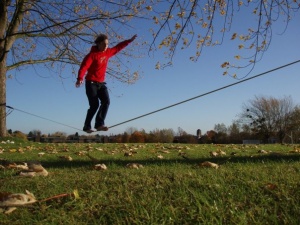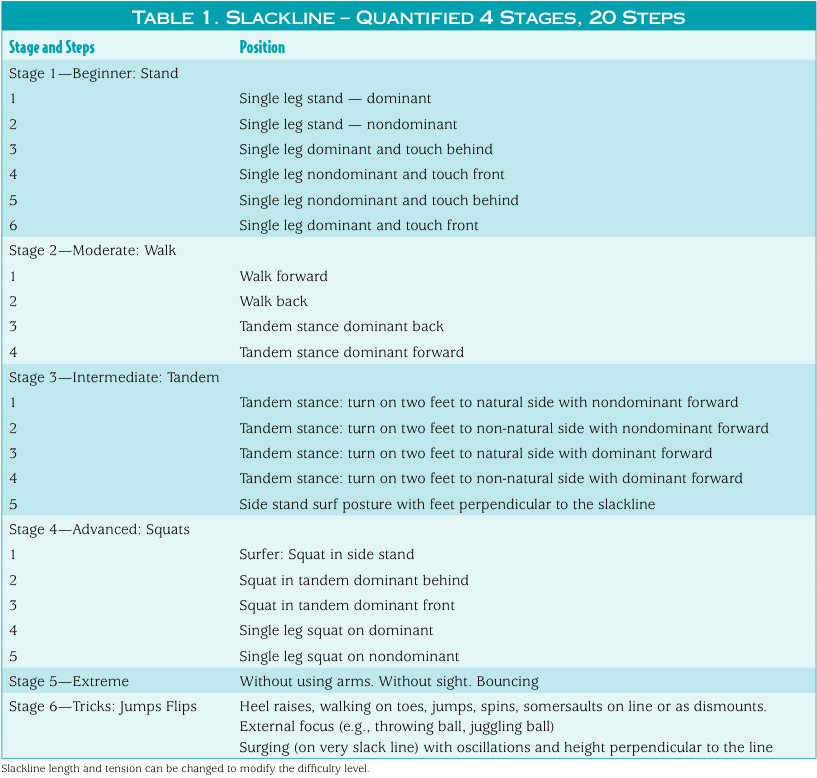Slacklining in rehabilitation: Difference between revisions
No edit summary |
Kim Jackson (talk | contribs) No edit summary |
||
| (20 intermediate revisions by 5 users not shown) | |||
| Line 1: | Line 1: | ||
<div class="editorbox"> | <div class="editorbox"> | ||
'''Original Editor '''- | '''Original Editor '''- Tony Lowe. | ||
'''Top Contributors''' - {{Special:Contributors/{{FULLPAGENAME}}}} | '''Top Contributors''' - {{Special:Contributors/{{FULLPAGENAME}}}} | ||
</div> | </div> | ||
== Description | == Description == | ||
Slacklining is an advanced balance activity which involves exercises (typically standing and walking) on a | [[Image:Slacklining.jpg|thumb|right]]Slacklining is an advanced neuromechanical [[balance]] activity which involves exercises (typically standing and walking) and balance retention on a tightened band such as webbing that is tensioned between two points. The whole-body dynamics drive the response to external environmental changes and the individual develops responses based upon motor learning processes. Studies have indicated that these balance activities can form a part of injury rehabilitation for the lower limb with particular effectiveness in developing balance, [[Core Strengthening|core strength]] and [[Quadriceps Muscle|quadriceps]] recruitment<ref name="gabel2014">Gabel, C. P., 2014, Slacklining: A Novel Exercise to Enhance Quadriceps Recruitment, Core Strength and Balance Control, Journal of Novel Physiotherapies 2014, 4:5 http://omicsgroup.org/journals/slacklining-a-novel-exercise-to-enhance-quadriceps-recruitment-core-strength-and-balance-control-2165-7025-229.php?aid=33632</ref><ref name="gabel2015">C.P. Gabel, J. Osborne, B. Burkett, 2015, The influence of ‘Slacklining’ on quadriceps rehabilitation, activation and intensity, Journal of Science and Medicine in Sport, Jan;18(1):62-6</ref><ref name="gabel2013">Charles P. Gabel, Simon Mendoza, 2013, Slacklining for Lower Extremity Rehabilitation and Injury Prevention, IJATT Volume 18, Issue 4, July</ref>. | ||
== Indication | The below 1 minute 44 sec. video gives the basics. | ||
{{#ev: youtube|2Gz3rbB3lCw}}<ref>REI Slacklining basics Available: https://www.youtube.com/watch?v=2Gz3rbB3lCw [accessed 17.9.2021] </ref> | |||
== Indication == | |||
Slacklining is relevant to prehabilitation, rehabilitation and desired improvements in skill based sporting achievement. | |||
== Clinical Presentation == | == Clinical Presentation == | ||
The response strategies that occur during slacklining are suited to individuals with deficiencies in four areas: | |||
*neuromechanical demand - integration of neurobiological, [[biomechanics]] and sensory components; | |||
*balance - equilibrium control regulating dynamic movement ; | |||
*postural control - the body's position in space; | |||
*and muscle strength - force generation, particularly for the quadriceps, [[Gluteus Maximus|gluteals]] and core. | |||
== Key Evidence == | == Key Evidence == | ||
Slacklining provides significant activation and recruitment of the quadriceps that is spontaneous at low levels of perceived exertion. This is particularly relevant for outpatients and when the quadriceps is inhibited and activation is required<ref name="gabel2015" />. | |||
Implementation of the slacklining protocols, Stages 1-5 and Steps 1-20 (see protocol below), within an individualized rehabilitation program over a series of weeks has shown to be effective an adjunct exercise to supplement recovery and facilitate sports specific rehabilitation<ref name="gabel2014" /><ref name="gabel2013" />. | |||
Slacklining improves postural control and enhances functional [[Knee|knee joint]] stability which is induced from enhanced preparatory muscle activation of the [[Rectus Femoris|rectus femoris]]<ref name="Pfusterschmied">Pfusterschmied J, Stöggl T, Buchecker M, Lindinger S, Wagner H, Müller E. Effects of 4-week slackline training on lower limb joint motion and muscle activation. J Sci Med Sport 2013;16:562-6.</ref>. | |||
Functionally the [[Hoffmann's Sign|Hofman-reflex]] is reduced through spontaneous down regulation that suppresses uncontrollable reflex mediated joint oscillations<ref name="Keller">Keller et al, 2013, Improved postural control after slackline training is accompanied by reduced H-reflexes, Scand J Med Sci Sports. 2012 Aug;22(4):471-7. http://www.ncbi.nlm.nih.gov/pubmed/21385217?dopt=Abstract</ref>. | |||
== Resources == | == Resources == | ||
An example protocol for using slackling in rehabilitation taken from Gabel & Mendoza 2013 <ref name="gabel2013" /> | |||
[[Image:Slackline_protocol.png|Example rehab protocol]] | |||
== Case Studies == | == Case Studies == | ||
See case study<ref name="gabel2013" /><div class="researchbox"> </div> | |||
= | |||
<div class="researchbox"> | |||
</div> | |||
== References == | == References == | ||
<references /> | |||
[[Category:Rehabilitation Interventions]] | |||
Latest revision as of 09:21, 16 September 2021
Original Editor - Tony Lowe.
Top Contributors - Tony Lowe, Lucinda hampton, Kim Jackson, WikiSysop and Naomi O'Reilly
Description[edit | edit source]
Slacklining is an advanced neuromechanical balance activity which involves exercises (typically standing and walking) and balance retention on a tightened band such as webbing that is tensioned between two points. The whole-body dynamics drive the response to external environmental changes and the individual develops responses based upon motor learning processes. Studies have indicated that these balance activities can form a part of injury rehabilitation for the lower limb with particular effectiveness in developing balance, core strength and quadriceps recruitment[1][2][3].
The below 1 minute 44 sec. video gives the basics.
Indication[edit | edit source]
Slacklining is relevant to prehabilitation, rehabilitation and desired improvements in skill based sporting achievement.
Clinical Presentation[edit | edit source]
The response strategies that occur during slacklining are suited to individuals with deficiencies in four areas:
- neuromechanical demand - integration of neurobiological, biomechanics and sensory components;
- balance - equilibrium control regulating dynamic movement ;
- postural control - the body's position in space;
- and muscle strength - force generation, particularly for the quadriceps, gluteals and core.
Key Evidence[edit | edit source]
Slacklining provides significant activation and recruitment of the quadriceps that is spontaneous at low levels of perceived exertion. This is particularly relevant for outpatients and when the quadriceps is inhibited and activation is required[2].
Implementation of the slacklining protocols, Stages 1-5 and Steps 1-20 (see protocol below), within an individualized rehabilitation program over a series of weeks has shown to be effective an adjunct exercise to supplement recovery and facilitate sports specific rehabilitation[1][3].
Slacklining improves postural control and enhances functional knee joint stability which is induced from enhanced preparatory muscle activation of the rectus femoris[5].
Functionally the Hofman-reflex is reduced through spontaneous down regulation that suppresses uncontrollable reflex mediated joint oscillations[6].
Resources[edit | edit source]
An example protocol for using slackling in rehabilitation taken from Gabel & Mendoza 2013 [3]
Case Studies[edit | edit source]
See case study[3]
References[edit | edit source]
- ↑ 1.0 1.1 Gabel, C. P., 2014, Slacklining: A Novel Exercise to Enhance Quadriceps Recruitment, Core Strength and Balance Control, Journal of Novel Physiotherapies 2014, 4:5 http://omicsgroup.org/journals/slacklining-a-novel-exercise-to-enhance-quadriceps-recruitment-core-strength-and-balance-control-2165-7025-229.php?aid=33632
- ↑ 2.0 2.1 C.P. Gabel, J. Osborne, B. Burkett, 2015, The influence of ‘Slacklining’ on quadriceps rehabilitation, activation and intensity, Journal of Science and Medicine in Sport, Jan;18(1):62-6
- ↑ 3.0 3.1 3.2 3.3 Charles P. Gabel, Simon Mendoza, 2013, Slacklining for Lower Extremity Rehabilitation and Injury Prevention, IJATT Volume 18, Issue 4, July
- ↑ REI Slacklining basics Available: https://www.youtube.com/watch?v=2Gz3rbB3lCw [accessed 17.9.2021]
- ↑ Pfusterschmied J, Stöggl T, Buchecker M, Lindinger S, Wagner H, Müller E. Effects of 4-week slackline training on lower limb joint motion and muscle activation. J Sci Med Sport 2013;16:562-6.
- ↑ Keller et al, 2013, Improved postural control after slackline training is accompanied by reduced H-reflexes, Scand J Med Sci Sports. 2012 Aug;22(4):471-7. http://www.ncbi.nlm.nih.gov/pubmed/21385217?dopt=Abstract








